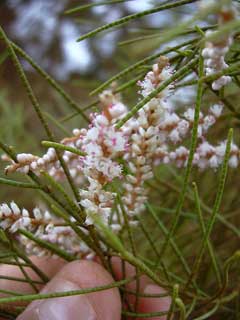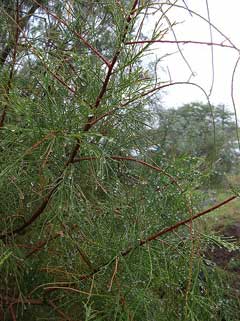 |
|
http://www.hear.org/starr/ |
 |
| http://www.hear.org/starr/ |
Translate this page:
Summary
Physical Characteristics

 Tamarix aphylla is a deciduous Tree growing to 10 m (32ft 10in) at a medium rate.
Tamarix aphylla is a deciduous Tree growing to 10 m (32ft 10in) at a medium rate.
See above for USDA hardiness. It is hardy to UK zone 8. It is in flower in July. The species is hermaphrodite (has both male and female organs) and is pollinated by Insects.
Suitable for: light (sandy), medium (loamy) and heavy (clay) soils, prefers well-drained soil and can grow in heavy clay and nutritionally poor soils. Suitable pH: mildly acid, neutral and basic (mildly alkaline) soils and can grow in very alkaline and saline soils.
It cannot grow in the shade. It prefers dry or moist soil. The plant can tolerate maritime exposure.
UK Hardiness Map
US Hardiness Map
Synonyms
T. articulata. T. orientalis.
Plant Habitats
Woodland Garden Canopy; Secondary; Hedge;
Edible Uses
Edible Parts: Manna
Edible Uses: Drink
A sweet manna-like substance that forms on the twigs is used to adulterate cane sugar[177, 183]. It can also be eaten with porridge etc or mixed with water to make a refreshing drink[183].
References More on Edible Uses
Medicinal Uses
Plants For A Future can not take any responsibility for any adverse effects from the use of plants. Always seek advice from a professional before using a plant medicinally.
Astringent Bitter
The galls are astringent[240]. The bark is astringent and bitter[240].
References More on Medicinal Uses
The Bookshop: Edible Plant Books
Our Latest books on Perennial Plants For Food Forests and Permaculture Gardens in paperback or digital formats.

Edible Tropical Plants
Food Forest Plants for Hotter Conditions: 250+ Plants For Tropical Food Forests & Permaculture Gardens.
More

Edible Temperate Plants
Plants for Your Food Forest: 500 Plants for Temperate Food Forests & Permaculture Gardens.
More

More Books
PFAF have eight books available in paperback and digital formats. Browse the shop for more information.
Shop Now
Other Uses
Hedge Hedge Tannin
Very tolerant of maritime exposure, it makes a good shelter hedge in coastal gardens[229]. Galls produced on the twigs and flowers (probably as a result of insect activity[K]) contain up to 55% tannin[223]. The wood has been used for fuel[257].
Special Uses
Hedge Hedge
References More on Other Uses
Cultivation details
An easily grown plant, succeeding in most soils and tolerant of saline conditions[11]. Grows well in heavy clay soils as well as in sands and even shingle[182]. Usually found near the coast, it succeeds inland if given a fairly good deep loam and a sunny position[11, 200]. Tolerant of maritime winds and dry soils when grown near the coast[11], plants require a moister soil and shelter from cold drying winds when they are grown inland in non-saline soils because they use the soil salts that are found in saline soils to help them reduce transpiration[200]. This species is not very hardy outdoors in Britain[1], but it succeed in the milder areas of the country, tolerating temperatures down to between -5 and -10°c[200]. This species flowers on the current year's growth[200]. Any pruning is best carried out in spring, hedges are also best trimmed at this time[188]. Plants are tolerant of severe pruning, sprouting freely from old wood[K]. Plants in this genus are notably resistant to honey fungus[200].
References Carbon Farming Information and Carbon Sequestration Information
Temperature Converter
Type a value in the Celsius field to convert the value to Fahrenheit:
Fahrenheit:
The PFAF Bookshop
Plants For A Future have a number of books available in paperback and digital form. Book titles include Edible Plants, Edible Perennials, Edible Trees,Edible Shrubs, Woodland Gardening, and Temperate Food Forest Plants. Our new book is Food Forest Plants For Hotter Conditions (Tropical and Sub-Tropical).
Shop Now
Plant Propagation
Seed - sow spring in a cold frame and only just cover the seed. When they are large enough to handle, prick the seedlings out into individual pots and grow them on in the greenhouse for their first winter. Plant them out into their permanent positions in late spring or early summer, after the last expected frosts. Cuttings of half-ripe wood, July/August in a frame. Very easy[200]. Cuttings of mature wood of the current seasons growth, 15 - 25cm long, planted outdoors in late autumn in a nursery bed or straight into their permanent position. High percentage[11, 200].
Other Names
If available other names are mentioned here
Native Range
TEMPERATE ASIA: Saudi Arabia, Yemen, Afghanistan, Egypt (Sinai), Iran (south) TROPICAL ASIA: India (Delhi, Gujarat, Punjab, Tamil Nadu, Uttar Pradesh, Haryana, Rajasthan), Pakistan AFRICA: Algeria, Egypt, Libya, Morocco, Tunisia, Eritrea, Ethiopia, Sudan, Somalia, Kenya, Mauritania, Senegal
Weed Potential
Right plant wrong place. We are currently updating this section.
Please note that a plant may be invasive in one area but may not in your area so it's worth checking.
Conservation Status
IUCN Red List of Threatened Plants Status :

Growth: S = slow M = medium F = fast. Soil: L = light (sandy) M = medium H = heavy (clay). pH: A = acid N = neutral B = basic (alkaline). Shade: F = full shade S = semi-shade N = no shade. Moisture: D = dry M = Moist We = wet Wa = water.
Now available:
Food Forest Plants for Mediterranean Conditions
350+ Perennial Plants For Mediterranean and Drier Food Forests and Permaculture Gardens.
[Paperback and eBook]
This is the third in Plants For A Future's series of plant guides for food forests tailored to
specific climate zones. Following volumes on temperate and tropical ecosystems, this book focuses
on species suited to Mediterranean conditions—regions with hot, dry summers and cool, wet winters,
often facing the added challenge of climate change.
Read More
Expert comment
Author
(L.)H.Karst.
Botanical References
200
Links / References
For a list of references used on this page please go here
Readers comment
© 2010, Plants For A Future. Plants For A Future is a charitable company limited by guarantee, registered in England and Wales. Charity No. 1057719, Company No. 3204567.